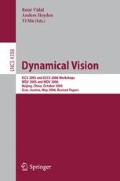Abstract
We study the rank and geometry of the multibody fundamental matrix, a geometric entity characterizing the two-view geometry of dynamic scenes consisting of multiple rigid-body motions. We derive an upper bound on the rank of the multibody fundamental matrix that depends on the number of independent translations. We also derive an algebraic characterization of the SVD of a multibody fundamental matrix in the case of two or odd number of rigid-body motions with a common rotation. This characterization allows us to project an arbitrary matrix onto the space of multibody fundamental matrices using linear algebraic techniques.
Access this chapter
Tax calculation will be finalised at checkout
Purchases are for personal use only
Preview
Unable to display preview. Download preview PDF.
References
Costeira, J., Kanade, T.: Multi-body factorization methods for motion analysis. In: IEEE International Conference on Computer Vision, pp. 1071–1076. IEEE, Los Alamitos (1995)
Fitzgibbon, A., Zisserman, A.: Multibody structure and motion: 3D reconstruction of independently moving objects. In: European Conference on Computer Vision, pp. 891–906 (2000)
Harris, J.: Algebraic Geometry: A First Course. Springer, Heidelberg (1992)
Hartley, R., Vidal, R.: The multibody trifocal tensor: Motion segmentation from 3 perspective views. In: IEEE Conference on Computer Vision and Pattern Recognition, vol. 1, pp. 769–775. IEEE, Los Alamitos (2004)
Kanatani, K.: Motion segmentation by subspace separation and model selection. In: IEEE International Conference on Computer Vision, vol. 2, pp. 586–591 (2001)
Kanatani, K.: Evaluation and selection of models for motion segmentation. In: Asian Conference on Computer Vision, pp. 7–12 (2002)
Ma, Y., Soatto, S., Kosecka, J., Sastry, S.: An Invitation to 3D Vision: From Images to Geometric Models. Springer, Heidelberg (2003)
Sturm, P.: Structure and motion for dynamic scenes - the case of points moving in planes. In: European Conference on Computer Vision, pp. 867–882 (2002)
Torr, P., Szeliski, R., Anandan, P.: An integrated Bayesian approach to layer extraction from image sequences. IEEE Transactions on Pattern Analysis and Machine Intelligence 23(3), 297–303 (2001)
Torr, P.H.S.: Geometric motion segmentation and model selection. Phil. Trans. Royal Society of London 356(1740), 1321–1340 (1998)
Vidal, R., Hartley, R.: Motion segmentation with missing data by PowerFactorization and Generalized PCA. In: IEEE Conference on Computer Vision and Pattern Recognition, vol. 2, pp. 310–316. IEEE, Los Alamitos (2004)
Vidal, R., Ma, Y.: A unified algebraic approach to 2-D and 3-D motion segmentation. In: European Conference on Computer Vision, pp. 1–15 (2004)
Vidal, R., Ma, Y., Piazzi, J.: A new GPCA algorithm for clustering subspaces by fitting, differentiating and dividing polynomials. In: IEEE Conference on Computer Vision and Pattern Recognition, vol. 1, pp. 510–517. IEEE, Los Alamitos (2004)
Vidal, R., Ma, Y., Soatto, S., Sastry, S.: Two-view multibody structure from motion. International Journal of Computer Vision 68(1), 7–25 (2006)
Vidal, R., Sastry, S.: Optimal segmentation of dynamic scenes from two perspective views. In: IEEE Conference on Computer Vision and Pattern Recognition, vol. 2, pp. 281–286. IEEE, Los Alamitos (2003)
Wolf, L., Shashua, A.: Two-body segmentation from two perspective views. In: IEEE Conference on Computer Vision and Pattern Recognition, pp. 263–270. IEEE, Los Alamitos (2001)
Wu, Y., Zhang, Z., Huang, T.S., Lin, J.Y.: Multibody grouping via orthogonal subspace decomposition. In: IEEE Conference on Computer Vision and Pattern Recognition, vol. 2, pp. 252–257. IEEE, Los Alamitos (2001)
Author information
Authors and Affiliations
Editor information
Rights and permissions
Copyright information
© 2007 Springer Berlin Heidelberg
About this paper
Cite this paper
Fan, X., Vidal, R. (2007). The Space of Multibody Fundamental Matrices: Rank, Geometry and Projection. In: Vidal, R., Heyden, A., Ma, Y. (eds) Dynamical Vision. WDV WDV 2006 2005. Lecture Notes in Computer Science, vol 4358. Springer, Berlin, Heidelberg. https://doi.org/10.1007/978-3-540-70932-9_1
Download citation
DOI: https://doi.org/10.1007/978-3-540-70932-9_1
Publisher Name: Springer, Berlin, Heidelberg
Print ISBN: 978-3-540-70931-2
Online ISBN: 978-3-540-70932-9
eBook Packages: Computer ScienceComputer Science (R0)

